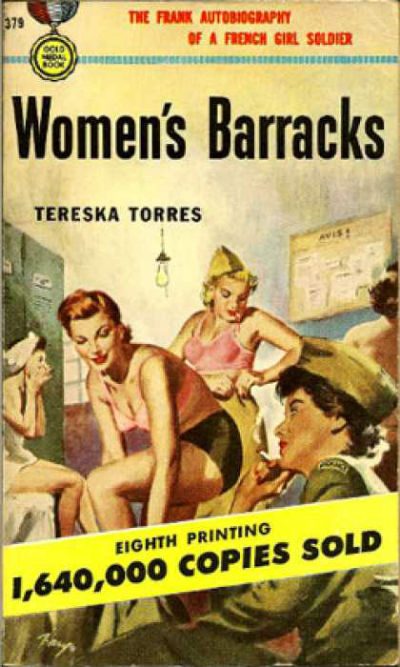Women’s Barracks was originally published in 1950 and was an account of life in London for a group of female Free French Army soldiers.
This was a fictionalised version of Torres’ own time in the services and was accused of being scandalous for its portrayal of the women’s sexual encounters, both with men and women.
This novel was seen as the birth of the lesbian themed publishing phenomenon that took place in America during the fifties and earlier sixties.
Women’s Barracks was published by Gold Medal Books and sold over four million copies in the USA, despite the book being banned for some time, due to its lesbian content. Recently .as part of a series which features pulp, noir and mystery novels by women of the 1930s, ’40s and ’50s, the novel was republished by the Feminist Press for their ‘Femme Fatale’ series.
On the cover of the 1962 edition from Consul Books, it follows the standard sensationalised cover art and suggestive descriptions of the novels content:
‘This is the story of what happens when scores of young girls live intimately together in a French military barracks. Many of those girls, utterly innocent and inexperienced, met other women who had lived every type of experience. Their problems, their temptations, their fights and failures are those faced by all women who are forced to live together without normal emotional outlets. It was these girls who chose Tereska Torres, the author, to confide in. They poured out to her their most intimate feelings, their secret thoughts, their fears. This is the true story of women in war. ‘
Whilst the example above actively promotes the books lesbian content, what’s interesting is that Torres herself was surprised by this notoriety and felt that her novel was simply a fictionalised depiction of the life she experienced during the war years. In an article in the British newspaper, The Independent, she was quoted to have been saddened that much of the focus on the book was about the notoriety of the lesbian relationship, rather than all the experiences of the army women. In the article, it says:
“I look on the internet and I learn that I am the literary queen of the lesbians, the person who wrote the first lesbian, erotic pulp novel. I hate it. I hate it,” Ms Torres said. “If you look at Women’s Barracks, there are five main characters. Only one and a half of them can be considered a lesbian.”
Women’s Barracks is not classified as a novel with purely lesbian content, as some of it’s successors in the genre were. What this novel did was show female same sex attraction in parallel with both bisexuality and heterosexuality. Torres as a narrator, doesn’t judge her characters and tells their story as honestly and respectfully as she could at the time.
Torres died in 2012. Although she found the focus on lesbian sexuality in the book frustrating, I would like to think that she understood the importance of the story she was telling. Women’s Barracks is an important part of the Lesbian Pulp literary canon, as it was seen, accidentally or not, as the beginning of the genre and enabled future authors to find publishers who were willing to market their stories. Unbeknownst to Torres herself, she was at the start of a hugely important part of lesbian literary history.
